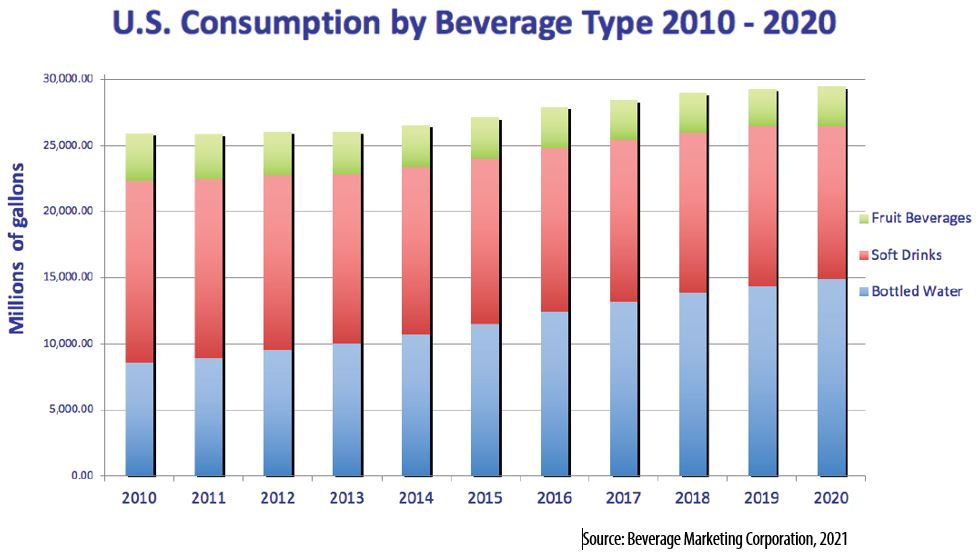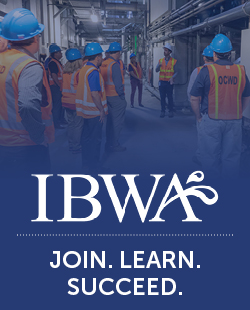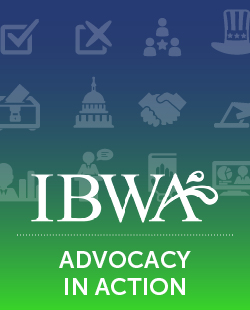Bottled Water Consumption Shift
Bottled Water Consumption Shift

Consumers are increasingly choosing bottled water instead of less healthy packaged drinks.
Bottled water reaffirmed its position as America’s favorite packaged drink in 2020, outselling all other packaged beverages (by volume) for a fifth year in a row, new data from the Beverage Marketing Corporation (BMC) shows.
For more than a decade, consumers have been increasingly choosing bottled water instead of less healthy packaged drinks. And the gap is widening, with per capita consumption of carbonated soft drinks dropping by 10 gallons since 2010, while bottled water increased by 17.4 gallons. This consumption shift, which highlights consumers’ preference for healthy hydration, means that Americans consumed nearly 5 trillion fewer calories in 2020 (15,140 calories per person).
Americans consumed 15 billion gallons of bottled water in 2020, up 4.2 percent from 2019 (compared to 3.7 percent increase the previous year). That means, on average, each American drank 45.2 gallons of bottled water in 2020, a 3.5 percent increase over the previous year. In addition, bottled water’s retail dollar sales grew in 2020, up 4.7 percent, reaching $36.3 billion, BMC data show.
A significant portion of bottled water’s growth (44 percent since 2010) has come from people switching to bottled water from other less-healthy packaged drinks. And nine out of ten Americans (91 percent) want bottled water to be available wherever other drinks are sold, according to a survey conducted on behalf of the International Bottled Water Association (IBWA) by The Harris Poll.
This healthy consumption shift from sugary drinks to bottled water could also work in reverse. If bottled water is not available, 74 percent of people say that they will turn to other packaged drinks, not tap water, The Harris Poll found.
“People are choosing to drink fewer calories and making that healthy choice of bottled water has the added benefit of helping the environment. Not only are bottled water containers 100 percent recyclable (including the cap) but they also use much less plastic than soda and other packaged beverages,” says Jill Culora, IBWA’s vice president of communications.
Soda containers, on average, use 142 percent more PET plastic than bottled water containers (23.9 grams vs. 9.89 grams for 16.9-ounce containers). Soft drinks and other sugary beverages need thicker plastic containers due to their carbonation and/or bottling processes.
Even with continuing growth and increased consumption, bottled water still has the smallest water and energy use footprint of any packaged beverage. On average, only 1.39 liters of water (including the 1 liter of water consumed) and 0.21 mega joules of energy are used to produce 1 liter of finished bottled water.
Most bottled water is packaged in 100 percent recyclable PET #1 plastic and HDPE #2 plastic, which are the plastics that are most recognized as being recyclable and the most recycled plastics in the world. This means consumers do not need to be confused about recycling bottled water containers because they are among the few consumer packaging types that are universally recyclable across the U.S. Not all cities and towns recycle glass bottles and laminated paper cartons.
Among all the items that get placed in recycle bins or taken to drop-off centers, an estimated 99 percent of all PET plastic bottles get recycled. Post-consumer PET and HDPE plastic is in huge demand by industries because they want to use that recycled plastic to make more products. Many bottled water companies use recycled PET and HDPE plastic to create new bottles, which reduces the need for virgin plastic.
We know that bottled water drinkers recycle more often than drinkers of other beverages. Of all the PET containers recycled through curbside collections systems, bottled water containers make up approximately 55 percent. Empty bottled water containers should always be returned or placed in a recycling bin, but when they are not, they make up 3.3 percent of all drink packaging that ends up in landfills, and only 0.02 percent of landfill waste.
In addition, plastic food and beverage containers (which includes bottled water) are not a significant contributor to ocean waste. Oxford University’s Our World in Data website reports that of all the plastic waste in the ocean, only 0.95 percent comes from Central and North America. The Oxford website says, “If we aim to address the ocean plastic problem, an understanding of this global picture is important . . . whilst countries across North America and Europe generate significant quantities of plastic waste (particularly on a per capita basis), well-managed waste streams mean that very little of this is at risk of ocean pollution. In fact, if North America and Europe were to completely eliminate plastic use, global mismanaged plastic would decline by less than 5 percent.”
According to BMC Chairman and CEO Michael C. Bellas, “Upward movement in per capita consumption indicates clear, persisting demand for a product that consumers see as a healthy alternative to other beverages.”
“Multiple inherent qualities explain bottled water’s ongoing appeal for U.S. consumers, including its association with healthfulness, convenience, safety and value.”
“Bottled water’s freedom from calories and artificial ingredients appeals to many consumers,” says Bellas. “Bottled water achieved its position at the apex of beverage rankings by enticing consumers away from other packaged beverages. Some consumers may have transitioned away from regular, full-calorie beverages in favor of their diet versions, but many others opted for bottled water instead. As some consumers became wary of artificial sweeteners, they shifted away from diet beverages as well as regular counterparts.”
“Consumer preference for healthy hydration and bottled water is really good news for public health,” says Culora. “This is particularly important as the nation continues to experience high rates of obesity, diabetes, and heart disease.”
“The bottled water industry is committed to helping people make healthier choices,” says Culora. “The demand for safe, healthy, and convenient water is evident, as bottled water continues to be America’s most popular packaged beverage, by volume.”
Whether you are at home, in the office, or on the go, IBWA encourages all consumers to make healthy hydration a part of their lifestyle and select bottled water as their beverage of choice and always recycle their empty containers—with the caps on.


